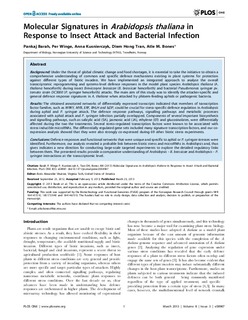| dc.contributor.author | Barah, Pankaj | |
| dc.contributor.author | Winge, Per | |
| dc.contributor.author | Kusnierczyk, Anna | |
| dc.contributor.author | Hong, Thi Diem Tran | |
| dc.contributor.author | Bones, Atle M. | |
| dc.date.accessioned | 2019-10-17T07:09:27Z | |
| dc.date.available | 2019-10-17T07:09:27Z | |
| dc.date.created | 2012-12-09T15:58:06Z | |
| dc.date.issued | 2013 | |
| dc.identifier.citation | PLOS ONE. 2013, 8(3): e58987 | nb_NO |
| dc.identifier.issn | 1932-6203 | |
| dc.identifier.uri | http://hdl.handle.net/11250/2622675 | |
| dc.description.abstract | Background
Under the threat of global climatic change and food shortages, it is essential to take the initiative to obtain a comprehensive understanding of common and specific defence mechanisms existing in plant systems for protection against different types of biotic invaders. We have implemented an integrated approach to analyse the overall transcriptomic reprogramming and systems-level defence responses in the model plant species Arabidopsis thaliana (A. thaliana henceforth) during insect Brevicoryne brassicae (B. brassicae henceforth) and bacterial Pseudomonas syringae pv. tomato strain DC3000 (P. syringae henceforth) attacks. The main aim of this study was to identify the attacker-specific and general defence response signatures in A. thaliana when attacked by phloem-feeding aphids or pathogenic bacteria.
Results
The obtained annotated networks of differentially expressed transcripts indicated that members of transcription factor families, such as WRKY, MYB, ERF, BHLH and bZIP, could be crucial for stress-specific defence regulation in Arabidopsis during aphid and P. syringae attack. The defence response pathways, signalling pathways and metabolic processes associated with aphid attack and P. syringae infection partially overlapped. Components of several important biosynthesis and signalling pathways, such as salicylic acid (SA), jasmonic acid (JA), ethylene (ET) and glucosinolates, were differentially affected during the two the treatments. Several stress-regulated transcription factors were known to be associated with stress-inducible microRNAs. The differentially regulated gene sets included many signature transcription factors, and our co-expression analysis showed that they were also strongly co-expressed during 69 other biotic stress experiments.
Conclusions
Defence responses and functional networks that were unique and specific to aphid or P. syringae stresses were identified. Furthermore, our analysis revealed a probable link between biotic stress and microRNAs in Arabidopsis and, thus gives indicates a new direction for conducting large-scale targeted experiments to explore the detailed regulatory links between them. The presented results provide a comparative understanding of Arabidopsis – B. brassicae and Arabidopsis – P. syringae interactions at the transcriptomic level. | nb_NO |
| dc.language.iso | eng | nb_NO |
| dc.publisher | Public Library of Science (PLOS) | nb_NO |
| dc.rights | Navngivelse 4.0 Internasjonal | * |
| dc.rights.uri | http://creativecommons.org/licenses/by/4.0/deed.no | * |
| dc.title | Molecular Signatures in Arabidopsis thaliana in Response to Insect Attack and Bacterial Infection | nb_NO |
| dc.type | Journal article | nb_NO |
| dc.type | Peer reviewed | nb_NO |
| dc.description.version | publishedVersion | nb_NO |
| dc.source.volume | 8 | nb_NO |
| dc.source.journal | PLOS ONE | nb_NO |
| dc.source.issue | 3 | nb_NO |
| dc.identifier.doi | 10.1371/journal.pone.0058987 | |
| dc.identifier.cristin | 970141 | |
| dc.description.localcode | Copyright: © 2013 Barah et al. This is an open-access article distributed under the terms of the Creative Commons Attribution License, which permits unrestricted use, distribution, and reproduction in any medium, provided the original author and source are credited. | nb_NO |
| cristin.unitcode | 194,66,10,0 | |
| cristin.unitname | Institutt for biologi | |
| cristin.ispublished | true | |
| cristin.fulltext | original | |
| cristin.qualitycode | 1 | |

